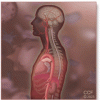Rheumatology
- Anchors away
Before you read this, I recommend that you read the interesting article in this issue by Prakash et al, part of our Symptoms to Diagnosis series.
- Elevated aminotransferases in a 62-year-old woman
Her medical history included gastroesophageal reflux disease and Sjögren syndrome. She had recently returned from travel to Malaysia.
- vOka vaccine-associated disseminated varicella zoster
The patient had received the live attenuated vaccine 1 month before presentation. He had no history of varicella infection.
- Unexplained pathology is not always autoimmune
Our success in understanding well-defined autoimmune diseases may make us too willing to attribute yet-unexplained conditions to autoimmunity simply because they share symptoms.
- Autoimmunity and postural orthostatic tachycardia syndrome: Implications in diagnosis and management
A review of the presentation and diagnostic evaluation, including atypical features that may suggest an alternative diagnosis requiring a more extensive evaluation.
- Finger nodules: Tip of the gouty iceberg
Recurrent, dramatic flares are the cardinal symptom of gouty disease, but some patients exhibit tophi on physical examination or imaging—without flares or pain.
- Reincarnating autoimmunity: Immune-related adverse events as new diseases
The range of adverse events is broad. Any organ can be affected, and any naturally occurring autoimmune process can be mimicked by the massive inflammation generated by checkpoint inhibition.
- Chronic centralized pain syndromes: A rheumatologist’s perspective
Centralized pain syndromes are vexing for patients and clinicians. In this issue, Volcheck and colleagues present a framework for understanding chronic centralized pain and for developing an actionable treatment plan for patients.
- Brodie abscess in an 87-year-old man
Though Brodie abscess is rare in older adults, timely diagnosis and treatment can prevent exacerbation of the abscess and avoid the need for additional surgical treatment, shortening the duration of hospitalization and preventing long-term complications.


